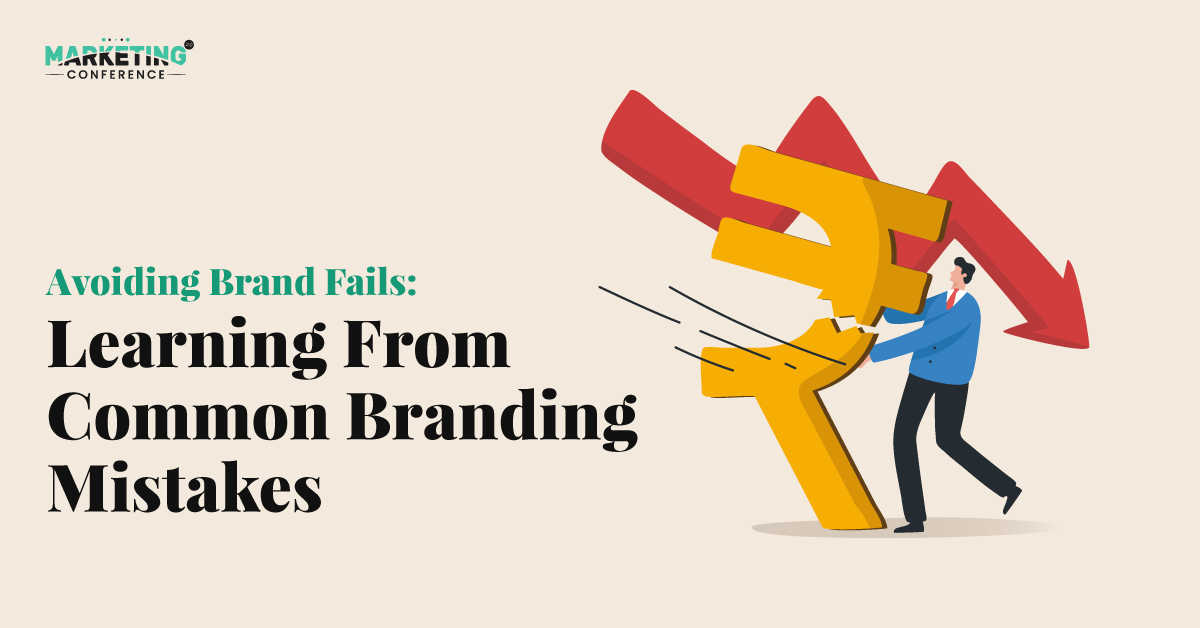In the ever-changing world of marketing, creating a successful brand means finding the right balance between creativity and carefulness. Every brand faces challenges, and we must learn from others' mistakes to stay ahead.
In this blog, we will explore insights from renowned marketing and retail conferences about common pitfalls to avoid and the best practices to follow when it comes to branding. We'll discover how staying true to your brand's identity, respecting different cultures, and handling social media smartly can make all the difference. Let’s learn from experts at the leading marketing event, Marketing 2.0 Conference, about how branding mishaps are avoidable, and by being informed and vigilant, you can steer your brand towards success.
Choosing Wisely: What Not To Do In Branding
Making the right choices can make or break a brand's reputation. To ensure your brand's success, it's essential to avoid common pitfalls that have tripped up many businesses before. Here are some insightful points on what not to do in branding:
- Ignoring Your Audience:
One of the gravest mistakes is disregarding your target audience's preferences and needs. According to a survey by HubSpot, 76% of consumers believe companies should understand their needs and expectations. Failing to connect with your audience can lead to a disengaged customer base and decreased loyalty.
- Inconsistent Brand Messaging:
Inconsistency confuses customers. Your brand should speak with a unified voice across all platforms. A study by Lucidpress found that consistent branding increases revenue by 23%. Avoid altering your brand message drastically, as it can create confusion and erode brand trust.
- Neglecting Market Research:
Skipping market research is a recipe for disaster. Understanding your competitors and the market landscape helps identify unique selling points and positioning opportunities. Studies have shown that businesses that invest in market research have a higher success rate.
- Ignoring Online Presence:
In the digital age, neglecting your online presence can be fatal. According to Statista, over 4.9 billion people use the internet globally. Not having a strong online presence means missing out on a vast pool of potential customers.
- Disregarding Customer Feedback:
Customer feedback is gold. It provides invaluable insights into your brand's strengths and weaknesses. Failing to address customer concerns can lead to negative reviews and a tarnished reputation.
Experts at famous retail conferences believe that by steering clear of these branding blunders, you can establish a solid foundation for your brand's growth and success. Remember, the key to effective branding lies in understanding your audience, staying consistent, conducting thorough market research, embracing the digital world, and valuing customer feedback.

Be True To Yourself: Staying Real With Your Brand
In a world bombarded with brands vying for attention, authenticity has emerged as a powerful differentiator. Staying true to your brand's essence and values can create a deep and lasting connection with customers. Let's delve into the importance of authenticity and how to avoid common pitfalls when staying real with your brand.
- Embrace Your Core Values:
Your brand's core values define its identity and purpose. According to a study by Cohn & Wolfe, 91% of consumers prefer brands that are authentic about their values. Align your actions with these values to build trust and loyalty.
- Avoid Greenwashing:
Don't claim to be environmentally friendly without substance. A Nielsen study revealed that 81% of consumers feel companies should help improve the environment. Be honest about your sustainability efforts and engage in genuine eco-friendly practices.
- Transparent Communication:
Open and honest communication builds credibility. Avoid exaggerations or false promises, as they can backfire and harm your brand's reputation.
- Stay Consistent Across Platforms: Consistency reinforces authenticity.
Ensure that your brand's voice, visuals, and messaging remain coherent across all channels. This coherence creates a recognizable and trustworthy brand identity.
- Learn from Mistakes:
Mistakes happen, but owning up to them demonstrates authenticity. Brands that acknowledge errors and take corrective actions often earn more respect and loyalty from customers.
Experts at Marketing 2.0 Conference agree that these steps will lead you on the path to building a brand that stands the test of time and resonates deeply with your customers.
Understanding Cultures: Respectful Global Branding
The world today is inter-connected and global branding offers immense opportunities for businesses. However, to succeed on the international stage, brands must navigate cultural nuances with finesse. Understanding and respecting diverse cultures is vital for building a strong global brand. Here are some essential points that marketing and real conferences stress to consider for respectful global branding:
- Cultural Research:
Before expanding into new markets, invest time and resources in cultural research. Understand the values, beliefs, and norms of the target audience. Cultural insights will guide you in tailoring your marketing messages to resonate with the local population.
For instance, a multinational corporation like Coca-Cola adapts its advertising campaigns to align with the cultural preferences of different countries, thus successfully connecting with diverse audiences.
- Language Matters:
Language barriers can lead to embarrassing and costly mistakes. Hiring professional translators ensures that your brand's messaging is culturally appropriate and free from unintended offensive meanings.
For instance, when Kentucky Fried Chicken (KFC) entered the Chinese market, they translated their slogan "Finger-lickin' good" to "Eat your fingers off," which was not well-received due to the cultural connotations.
- Symbolism and Colors:
Symbols and colors carry significant cultural meaning. For instance, the color red is considered lucky in Chinese culture and is often associated with prosperity, while it may symbolize danger or warning in Western cultures. Understanding such cultural nuances will help you design brand logos, packaging, and visuals that resonate positively with your target audience.
- Adaptation, not Standardization:
Avoid the pitfall of standardized marketing across all markets. Instead, adapt your branding and marketing strategies to suit the preferences and needs of each region.
McDonald's is a prime example of successful adaptation, offering localized menu items like the "McAloo Tikki" in India and "Teriyaki Burger" in Japan.
Retail conferences strongly project that by taking these considerations into account, your brand can establish a respectful and authentic presence in global markets. Understanding and embracing cultural diversity will foster trust, loyalty, and positive brand perception among a diverse range of consumers worldwide.

Social Media Smart: Navigating Branding Online
In the digital age, social media has become a pivotal platform for brand exposure and engagement. However, one misstep in this fast-paced world can quickly escalate into a branding disaster. To ensure your brand thrives online, it's crucial to be social media smart. Here are some essential tips straight from leading marketing events, for navigating branding on social media:
- Know Your Audience:
Understanding your target audience's preferences and behaviors on social media is essential. According to Sprout Social, 79% of consumers expect brands to demonstrate an understanding of their needs. Tailor your content to resonate with your followers, building meaningful connections.
- Consistent Brand Voice:
Your brand's voice should be consistent across all social media channels. Consistency fosters brand recognition and trust. Buffer reported that consistent brands are worth 20% more than those with inconsistent messaging.
- Avoid Controversial Topics:
Steer clear of divisive or controversial topics that could alienate your audience. A study by Edelman revealed that 53% of consumers believe brands should avoid taking a stance on controversial issues.
- Respond to Feedback Promptly:
Social media is a two-way street. Address customer inquiries and feedback promptly and professionally. According to Convince & Convert, 42% of consumers expect a response from brands within 60 minutes on social media.
- Be Authentic and Transparent:
Honesty and transparency are crucial for online success. Brands that show authenticity and transparency are more likely to gain trust and loyalty. A Label Insight survey found that 94% of consumers are more likely to be loyal to a brand that offers complete transparency.
- Measure and Analyze:
Regularly analyze your social media metrics to understand what works and what doesn't. Metrics such as engagement rate, reach, and conversion can provide valuable insights to refine your social media strategy.
Bouncing Back: Recovering from Branding Slip-ups
Branding mistakes are bound to happen, but how you handle them can determine your brand's fate. Here's how experts at marketing and retail events suggest you can recover from branding slip-ups in just 3 key steps:
- Swift Acknowledgment: The key to recovering from a branding slip-up is to promptly acknowledge the mistake. By doing so, you demonstrate accountability and a commitment to resolving the issue.
- Apologize Sincerely: A sincere and genuine apology is a powerful tool for rebuilding trust with your audience. When you apologize from the heart, it shows that you genuinely care about your customers' feelings.
- Learn and Adapt: Embrace the branding mistake as an opportunity for growth. Analyze the root cause of the problem and learn from it. Implement necessary changes to your processes, policies, or strategies to prevent similar blunders in the future. Demonstrating a willingness to adapt and improve shows resilience and maturity as a brand.
Bottom Line
Learning from common branding mistakes empowers businesses to avoid potential disasters and foster successful brand strategies. Embracing authenticity, cultural sensitivity, social media savvy, and prompt recovery from slip-ups are key to a brand's longevity and trustworthiness.
Marketing 2.0 Conference, being one of the most anticipated marketing events globally, serves as a vital platform, where industry experts share valuable insights, best practices, and case studies to guide marketers in making informed decisions. By continuously evolving with the wisdom gained from such marketing and retail conferences, brands can confidently forge ahead, steering clear of branding failures and charting a course towards sustained success.





